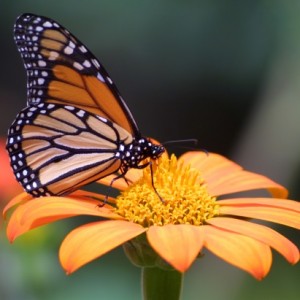06
Jan
Fish and Wildlife Service to Consider Federal Protection for Monarch Butterfly
(Beyond Pesticides, January 6, 2015) At the close of 2014, the U.S. Fish and Wildlife Service (FWS) announced plans to conduct a year-long status review of the monarch butterfly to determine whether the species is eligible for protection under the Endangered Species Act (ESA). FWS is taking this action as result of an August 2014 legal petition filed by health and environmental groups that presented substantial information indicating that listing under the ESA may be warranted. In November 2014, Beyond Pesticides joined over 200 environmental groups and businesses in a letter asking for federal protection for monarch butterflies in the wake of shocking declines.
 The North American monarch butterfly population fell by 90 percent in the past 20 years, dropping from a high of approximately one billion in the mid-1990s to fewer than 35 million butterflies in the winter of 2013-2014— the lowest number ever recorded. Each year monarch butterflies travel over 2,000 miles between Canada, the U.S., and Mexico, across multiple generations, to reach their winter hibernation grounds in late October. As FWS indicates, this journey has become “more perilous for many monarchs” due to threats along their migratory paths. Scientists believe the butterfly’s decline is being driven in large part by the loss of milkweed plants in the Midwest where most monarchs are born. FWS also mentions the direct threat of moralities from pesticide exposure.
The North American monarch butterfly population fell by 90 percent in the past 20 years, dropping from a high of approximately one billion in the mid-1990s to fewer than 35 million butterflies in the winter of 2013-2014— the lowest number ever recorded. Each year monarch butterflies travel over 2,000 miles between Canada, the U.S., and Mexico, across multiple generations, to reach their winter hibernation grounds in late October. As FWS indicates, this journey has become “more perilous for many monarchs” due to threats along their migratory paths. Scientists believe the butterfly’s decline is being driven in large part by the loss of milkweed plants in the Midwest where most monarchs are born. FWS also mentions the direct threat of moralities from pesticide exposure.
Milkweed plants are the only food source monarch larvae are able to eat, making them critical for the butterfly’s long-term survival. According to a study published in the Journal of Animal Ecology in 2014, one of the primary reasons for milkweed decline is the rise of genetically engineered (GE) crops tolerant of herbicides such as glyphosate (Roundup). The expansion of GE agriculture over the past two decades has resulted in significant increases in herbicide use. In practice, these chemicals act non-selectively on weeds, resulting in widespread elimination of habitat that includes milkweed and other plants beneficial to pollinator populations. GE crops are often coated in toxic neonicotinoids, an insecticide that has been implicated in the global decline of honey bees.
FWS’ consideration of federal protection for monarchs is a positive step towards improving habitat and raising awareness about the decline of the butterfly, as well as the plight of other pollinator populations. In late October 2014, the U.S. Department of Agriculture (USDA) provided an additional $4 million on top of $3 million pilot investment announced earlier last year to help farmers and ranchers provide habitat for pollinators. At the same time, the Council on Environmental Quality announced new guidelines to help federal agencies incorporate pollinator friendly practices at federal facilities and on federal lands. These actions are a response to a Presidential Memorandum issued at the close of National Pollinator Week 2014, which directed federal agencies to establish a pollinator health task force and develop a pollinator health strategy. Despite a requirement that a strategy be developed within 180 days, a plan is not likely to be released until late this winter.
FWS has opened a 90 day public comment period for the ESA review, which is available at regulations.gov under docket number FWS-R3-ES-2014-0056. The ESA allows species to be listed as “threatened” when they are at risk of becoming endangered in a significant portion of their range. This would allow for the protection of the species but also still allow the continuation of activities that promote their conservation, such as scientific research and monitoring, citizen monitoring and tagging, and non-commercial classroom and household rearing of monarchs for educational purposes. In its press release FWS indicates that it is specifically interested in garnering public input on the following points:
- The subspecies’ biology, range and population trends, habitat requirements, genetics and taxonomy;
- Historical and current range, including distribution patterns;
- Historical and current population levels and current and projected trends;
- The life history or behavior of the monarch butterfly that has not yet been documented;
- Thermo-tolerance range and microclimate requirements of the monarch butterfly;
- Past and ongoing conservation measures for the subspecies, its habitat or both; and,
- Factors that are the basis for making a listing determination under section 4(a) of the ESA;
In addition to providing a public comment in support of listing the monarch under the ESA, residents can take action in their own backyards to support populations of monarchs, bees, and other pollinators. A necessary first step is to avoid using toxic pesticides in and around your home, and encourage others to do the same. Planting milkweed in your backyard is a surefire way to help monarch populations, and for other helpful tips, see Beyond Pesticides’ webpage on Managing Landscapes with Pollinators in Mind. Concerned residents can also read up on the numerous threats monarchs and other pollinators are experiencing in the article Bees, Birds, and Beneficial’s: How Fields of Poison Adversely Affect Non-target Organisms, and find more ways to take action in your community through the BEE Protective webpage.
All unattributed positions and opinions in this piece are those of Beyond Pesticides.
Sources: Fish and Wildlife Service Press Release, St. Louis Post-Dispatch










